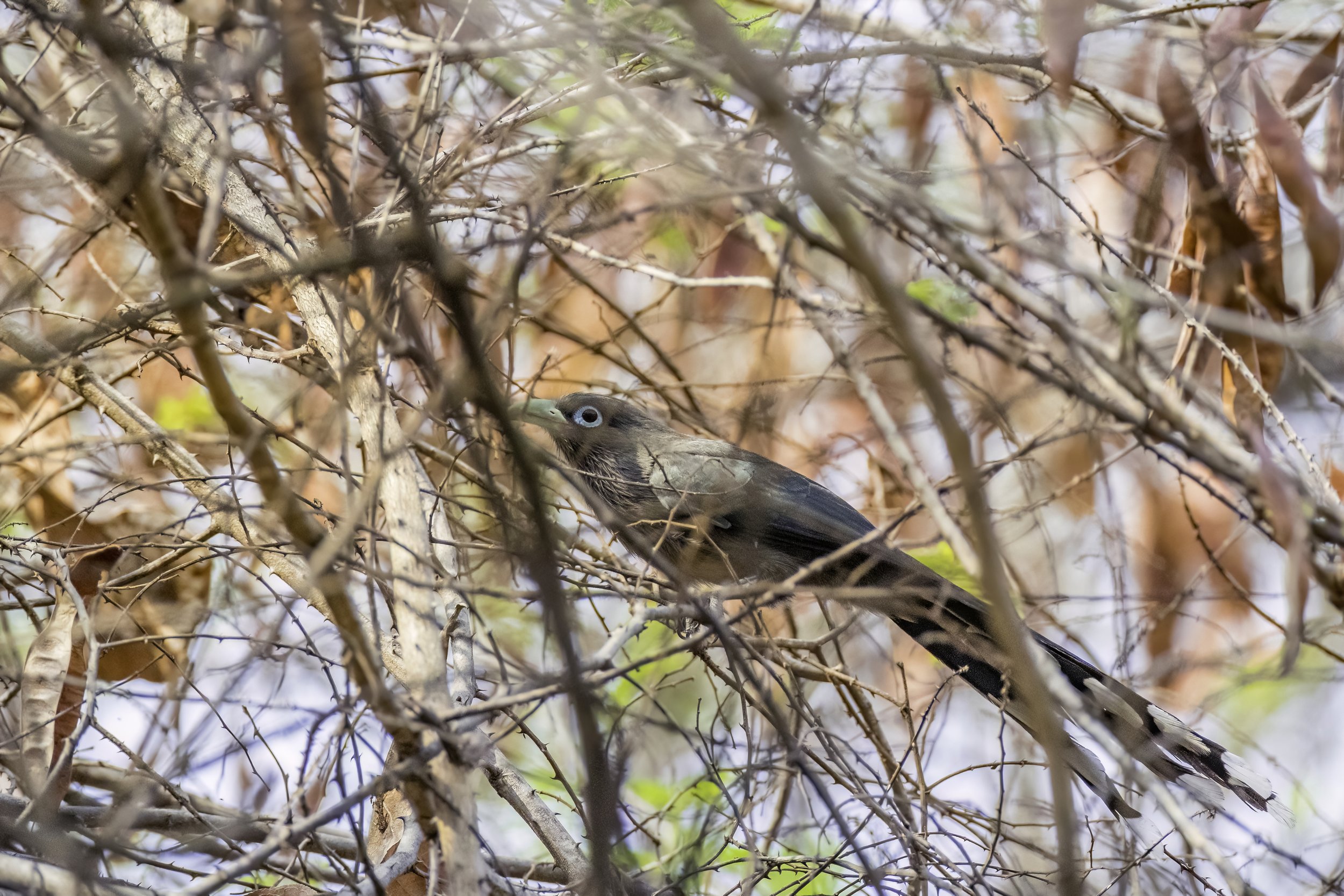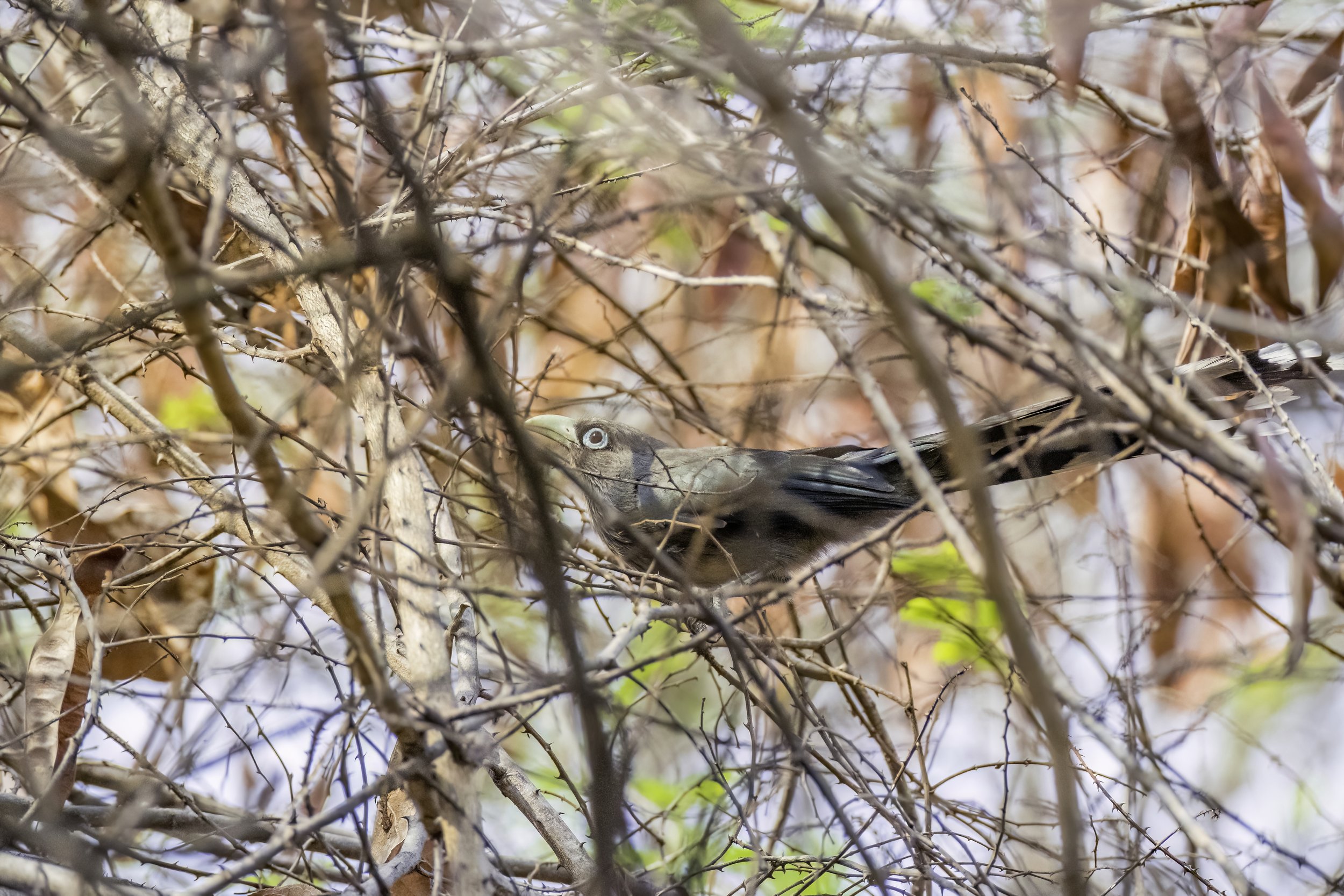Blue-faced Malkoha
Phaenicophaeus viridirostris
Ananthagiri Forest Range, Vikarabad
This week too I will continue to roam the Ananthagiri Forest Range and this time it is for the very shy Blue-faced Malkoha or the Small Green-billed Malkoha which is a long-tailed gray cuckoo with a pale blue eye-ring and an ivory-coloured bill. Note the broad white tips to the under tail feathers. It clambers about in trees and thickets, either singly or in pairs inhabiting lowland and hill areas, where it favours thorny scrub and second growth. This is the habitat I saw it in and it took some effort as it didn’t once come out into the open for a clear photo.
Located in the central stretch of the Deccan Plateau, Telangana has sub-tropical climate and the terrain consists mostly of hills, mountain ranges, and thick dense forests covering an area of 27,292 km2 (10,538 sq mi). The annual rainfall ranges between 1,100 mm to 1,200 mm and the annual temperature varies from 15 C to 45 C. The State is drained by a number of rivers which include Godavari and Krishna.
Telangana is endowed with rich diversity of flora and fauna. It has dense teak forests on the northern part along the banks of river Godavari. As per the Champion & Seth Classification of Forest Types (1968), the forests in Telangana belong to three Forest Type groups, which are further divided into 12 Forest Types. The State Government has taken up a massive greening programme, 'Telangana Ku Harita Haram' in the State to plant and protect 230 crore seedlings over a period of 4 years. This initiative aims at achieving the twin objectives of increasing the forest cover and reduce pressure on the existing forest resources, through massive community participation by Vana Samrakshna Samithis (VSS) and Eco-Development Committees (EDCs) in Protected Areas and Watershed Development Committees in the Watershed areas. Recorded Forest Area (RFA) in the State is 26,904 sq km of which 20,353 sq km is Reserved Forest, 5,939 sq km is Protected Forest and 612 sq km is Unclassed Forests. In Telangana, during the period 1st January 2015 to 5th February 2019, a total of 9,420 hectares of forest land was diverted for non-forestry purposes under the Forest Conservation Act, 1980 (MoEF & CC, 2019). As per the information received from the State during that last two years, 12,730 ha of plantations including avenue plantations in the State.
Three National Parks and nine Wildlife Sanctuaries constitute the Protected Area network of the State covering 5.08% of its geographical area and our focus area today is the northern fringe of the Nallamalla forest located both in Telangana and Andhra Pradesh. It is part of the Eastern Ghats. The Nagarjunsagar-Srisailam Tiger Reserve, the largest tiger reserve in India spread over the five districts of Kurnool, Prakasam, Guntur, Nalgonda and Mahabub Nagar falls in its precincts.
Ananthagiri Hills & Forest Range
Ananthagiri Hills is located in the Vikarabad district of Telangana. It is one of two major reserve forest blocks of the Vikarabad Forest Range the other one being the Damagundam Forest Reserve and each of these forest blocks is spread over a 10 square kilometre area. While the limits of Damagundam begin from Manneguda, a small town about 60 kms from Hyderabad, Ananthagiri block begins where the limits of Vikarabad end near the railway tracks. The Ananthagiri hills and their dense forests host many wild species like the Nilgai, Sambhar, Black Buck, Chital, Chowsingha, Chinkara, Wild Goats and many more. The streams from these hills flows into Osman Sagar, also known as the Gandipet lake, and Himayath Sagar. It is one of the denser forests in Telangana and is the birthplace (about 5 kilometers from the town of Vikarabad) of the Musi river, also known as the Muchkunda River, which flows through the capital city, Hyderabad. The Musi River after originating in these Ananthagiri Hills, about 90 kilometers to the west of Hyderabad and flowing due east for almost all of its course joins the Krishna River at Wadapally in the Nalgonda district after covering a total distance of about 240 km. Also in these forests is the Sri Anantha Padmanabha Swamy Temple, a Hindu temple dedicated to the Lord Vishnu.
According to the Skanda Purana it is believed this temple was installed by Rishi Markandeya in the Dvapara Yuga. Attracted by the peaceful atmosphere of the Ananthagiri Hills Rishi Markandeya came here for yoga sadhana. It is believed that the Rishi, on the strength of his spiritual powers, would visit Kasi daily for a bath in the sacred Ganges through a cave. One day he was not able to visit Kasi because the Dwadasi was in the early hours of the morning. Because of this miss the Lord Vishnu appeared, gave Darshan, in a dream and arranged for the Ganges to flow so the Rishi could take his bath daily without having to travel.
About 400 years back the Nizams of Hyderabad used these forests as their hunting grounds. It is said that the lord Vishnu in the form of Sri Anantha Padmanabha Swamy appeared in a dream and asked the then Nizam, Mir Osman Ali Khan, to build a temple for him. About 20 kilometers from the temple lies the Nagasamudram Lake or Kotipally Reservoir, a masonry dam.
It is one of the earliest habitat areas with ancient caves, medieval fort structures and temples that illustrate the antiquity of this area.
I love these forests as they are home to innumerable bird species, some of which I have photographed and many more which I am yet to photograph. I only hope the so called “bird and nature lovers” who come here to photograph and achieve social media fame adhere to ethical birding practices and refrain from using calls, especially owl calls, and bait.
Read about some of the other birds I’ve photographed in these beautiful forests.
Blue-faced Malkoha/ Small Green-billed Malkoha
The Blue-faced Malkoha (Phaenicophaeus viridirostris) or small Green-billed Malkoha, is a non-parasitic cuckoo found in the scrub and deciduous forests of peninsular India and Sri Lanka. It has a waxy, dark, blue-grey plumage on its upperparts and has a long tail with graduated white-tipped feathers. The throat and chin are dark with spiny pale feathers that are branched. The lower belly is a dull creamy to rufous colour. The bill is apple green, and a naked patch of blue skin surrounds the eye. The sexes are alike. The blue-faced malkoha is a bird of open forests and scrub jungle.
It is a large species at 39 cm, its back and head are dark grey with an oily green or blue gloss, and the dark tail has graduated feathers tipped with white. The belly is pale ochre to grey. The feathers of the chin and throat are branched (unlike in Phaenicophaeus tristis) with the branched tips being pointed and slightly yellowish giving the throat a streaked and spiny appearance. There is a large blue patch around the eye, with a white fringed red iris, and the bill is apple green. The sexes are indistinguishable by external appearance. Birds from Sri Lanka have a broader white tip to the tail feathers. Malkohas are generally very silent but will sometimes produce a low croaky kraa when flushed. Young birds have dull and non glossy upper parts and some brown feathers in their wing.
They nest within a thorny bush, building a thick platform of twigs lined with green leaves and lay a clutch of two, rarely three, chalky white eggs. The breeding season is somewhat extended and unclear but many nest have been taken from March to August. Two out of 31 specimens trapped in a study were found to have ticks of the genus Haemaphysalis spinigera.
The blue-faced malkoha takes a variety of insects, caterpillars and small vertebrates. It usually forages in the undergrowth.
The blue-faced malkoha is found in peninsular India south of Baroda (the Surat Dangs) and Cuttack in a range of habitats from semi-evergreen, dry deciduous and open scrub forest. In Sri Lanka it is restricted to the plains.
The Blue-faced Malkoha is about 39 cm long and weighs about 77 grams. The adult male is a greenish grey above, with a slate-grey head, glossy blue-green wings and a long tail graduated, black with white tips. The throat and breast are dark grey with light grey hackles forked at the tip (which appear wet), the belly is grey and buff and the undertail-coverts are dark grey. There is a colourful patch of bare pale blue skin around the eye, iris with narrow a white outer ring, dark red inner ring, bill pale green, with slaty-blue feet. The juvenile is less green-glossed above, paler below; the outer primary softer and broader than in the adult (where sickle-shaped), the tail feathers are narrower, central pair with narrow pale tip. Their flight is slow, direct, laboured, on short, rounded wings.
It forages on Insects, caterpillars, grasshoppers, mantids, cicadas, beetles; also lizards, fruit. It spends time in branches and thickets, peering at leaves for insects; usually singly or in pairs.
It breeds nearly all year, mainly between March and May in South India and they nest within a thorny bush, building a bulky saucer of twigs lined with green leaves, near ground to 1–2 m above. It lays 2 rarely 3 chalky white eggs. The hatchlings are born with blackish skin and white hair-like down.
These malkohas are not globally threatened and are widespread though not abundant throughout most of its range, in a habitat that is not immediately at risk; common in dry zone of low country in Sri Lanka, e.g. in Uda Walawe, Bundala and Yala National Parks. Their usual habitat is secondary woodland, thorn scrub and bush, especially with Euphorbia antiquorum and in low country to hills at 1000 m.
‡‡‡‡‡
For a print of the beautiful birds from my various sojourns click on the button below to read my process and order a limited edition canvas.
‡‡‡‡‡
Related Posts
















